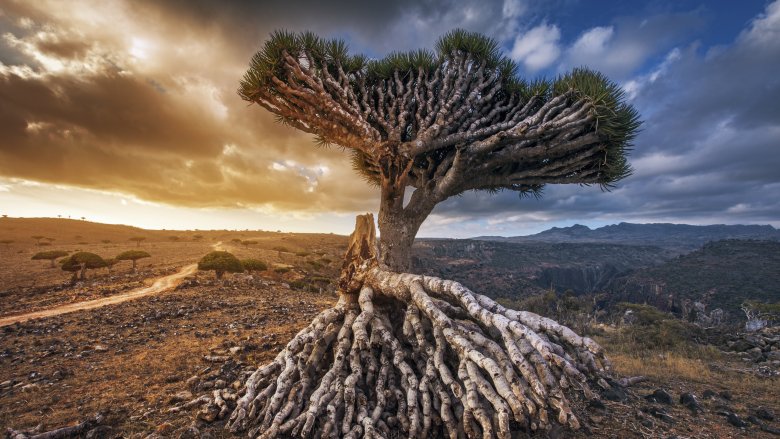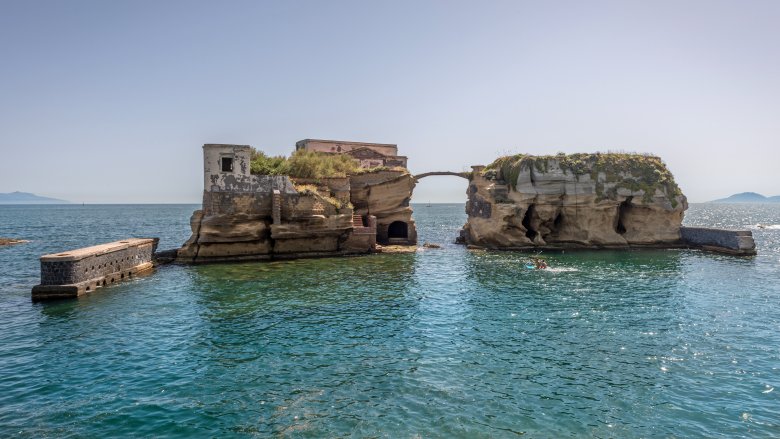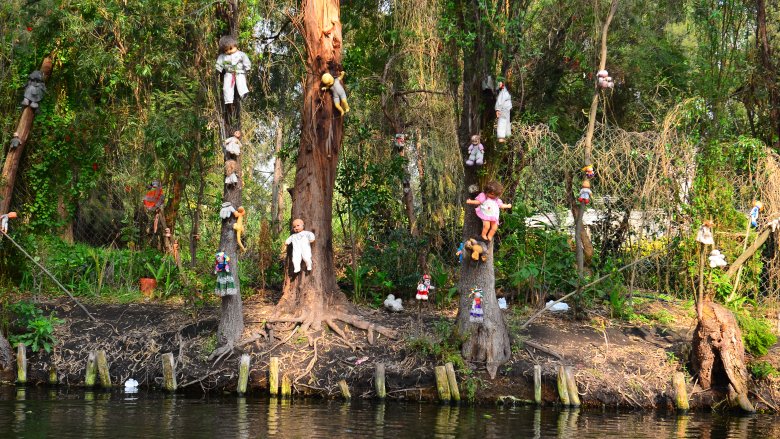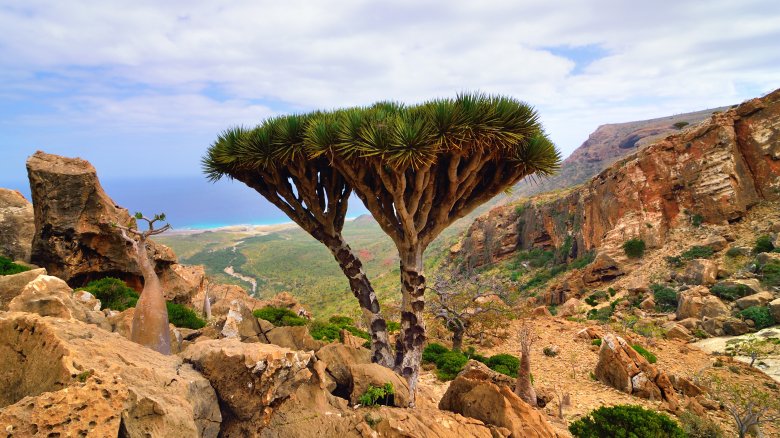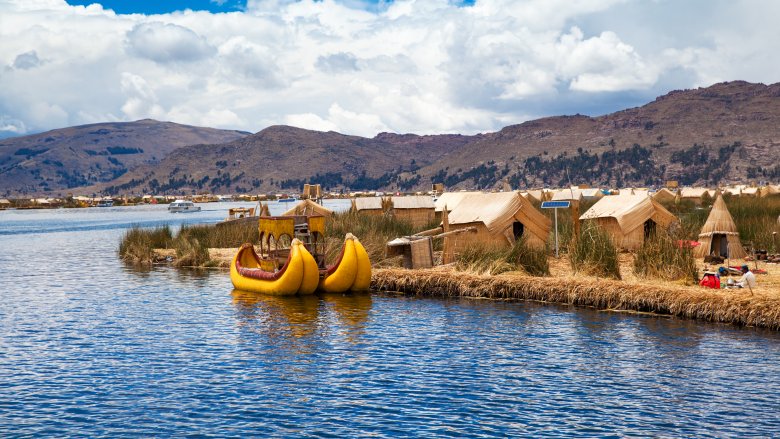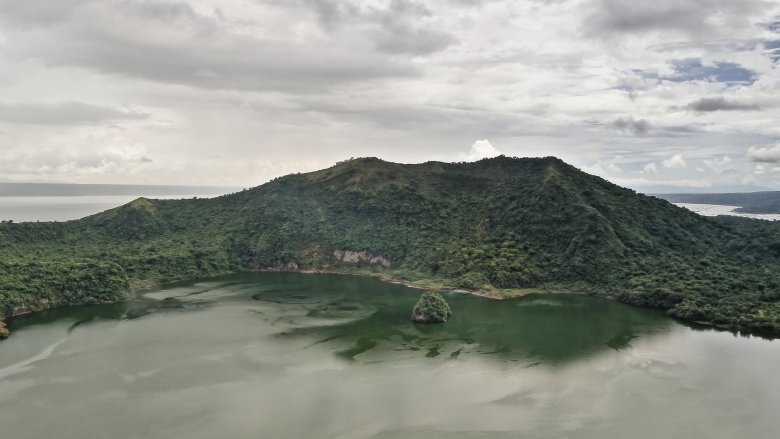Unusual Islands You Never Knew Existed
Most mysterious islands don't have smoke monsters or a Dharma Initiative, but even in the real world, there are some surprisingly freaky landmasses hiding out in the ocean. If you're looking to take your next vacation in a place that none of your friends have ever been to — much less heard of — then some of these bizarre secret islands might be right up your alley, while other ones are permanently off-limits to tourists (often for good reasons).
Tangier, where Virginians speak a different form of English
If you've ever taken a road trip across the United States, you know it's sometimes debatable whether Bostonians and Louisianians really speak the same language. However, no one else in America talks like the residents of Tangier, a small island just 12 miles off the coast of Virginia, where residents speak an unusual form of English that many scholars believe may date back hundreds of years, according to National Geographic. The mostly Methodist population of Tangier has been isolated from the mainland United States since the Civil War, when it chose not to join the Confederacy.
This separation allowed a unique culture to thrive on the island, where roughly 500 residents use golf carts to get around, and the economy has traditionally been based on fishing and crabbing. The language is definitely the weirdest result, though, with Tangier locals speaking in a way that can be almost indecipherable to other English speakers. Part of this is because they use vowels differently, part of it is because they do a lot of what they call "speaking backward" (which is similar to sarcasm), and then they have their own slang on top of that. Casual Tangier discussion includes phrases like "coferdbent" (which means "twisted"), as well as "spar grass" for asparagus, or "my bike's bust" to refer to a bicycle with a flat tire. Interested travelers looking to broaden their view on English accents can catch a ferry from mainland Virginia.
Tashirojima, Japan's island of cats
If you're allergic to cat dander, this little place is your worst nightmare. On the other hand, if you're one of those cat people who made a Facebook page for your feline fur baby, then Japan's island of cats might be your dream vacation.
As written by Slate, the island of Tashirojima boasts a population of only about 100 people, who are ruled over by several hundred benevolent feline masters. There's even a little cat shrine in the middle of the island, and weary travelers can hit the hay in a number of cat-shaped cabins. Cats will be found everywhere you look and are presumably quite comfortable with humans.
But wait, where'd all the cats come from? Well, the story goes that they got shipped to Tashirojima sometime in the 1700s or 1800s to help kill rodents. Back then, the economy of Tashirojima was dependent on textiles from silkworms, and those silkworms kept falling prey to mice. After the cats took care of that little problem, they started approaching fishermen to snatch up a little extra food. The fisherman believed the cats were good luck, and the felines have presided over the island ever since.
Isola della Gaiola, the cursed island you don't want to live on
Off the coast of Naples, these two tiny islets, linked by a single elevated footbridge, would seem like the ultimate place to soak in the world's beauty. Boasting both ancient Roman ruins and majestic cliffs, it's hard to imagine a more fanciful spot. According to Atlas Obscura, some believe Virgil may have taught his students here. But don't get too swept up in the pretty sights because Isola della Gaiola has a nasty reputation.
See, Gaiola's history is haunted by rumors of a "curse." Like the infamous Bermuda Triangle, a number of tragic events have been connected to the island, but whether these are coincidences or a grand mythic conspiracy depends on your point of view. According to Australian Broadcasting Corporation, the legend goes that a private man referred to as "the Wizard" lived on the island in the early 1800s. Since then, a long line of wealthy owners have allegedly purchased the island, only for various hideous fates to befall them afterward.
This makes a great story, but the links are a bit tenuous. For example, the island's most famous owner was probably J. Paul Getty, who wrote in his autobiography that he purchased Gaiola around the mid-1960s. According to believers of the "curse," this purchase led to the 1973 kidnapping of his son, an event recently adapted into the Ridley Scott film All the Money in the World, according to Time. Curse or no curse, the island is now abandoned.
North Sentinel Island, a place untouched by the outside world
In the age of globalization, it's hard to believe there's any spot left untouched by the culture, technology, and shared historical narratives of our society. Surprisingly enough, there's a place we call North Sentinel Island — though the residents themselves certainly don't call it that — which is a little speck of land in the Bay of Bengal. The native population of North Sentinel Island has openly rejected all attempts at contact from the outside world, firing off arrows anytime someone tries to invade their home.
The "Sentinelese" population, estimated to be anywhere from 50 to 500 people, are what the Independent calls "one of the last uncontacted tribes in the world." As Business Insider points out, it seems the Sentinelese haven't developed agriculture, so they still live a hunter/gatherer lifestyle.
The Independent explains that even though there were prior expeditions to make contact, India's government has now mandated that the tribe must remain undisturbed. The island's people have made it clear they don't anyone invading their space — hard to get much clearer than an arrow, right? — and even more importantly, the island's secluded nature means the inhabitants are highly vulnerable to any diseases we might be carrying, meaning even minimal contact could decimate the population. This is one island none of us should ever set foot on.
Isla de las Munecas, the island of the dead dolls
It doesn't get much creepier than Isla de las Munecas, which is probably still in the nightmares of anyone who's visited. Not far from Mexico City, the island (technically a small lake peninsula, but whatever) is haunted by the legend of a caretaker, Don Julian Santana, who claimed to have found a dead girl floating in the canal over 50 years ago, according to Huffington Post. Though Santana's family says the dead girl never existed, the caretaker claimed he wanted to help the girl's ghost find happiness in the afterlife. To do this, he began stringing up dolls for her, all over the island. Today, those dolls are hanging from fences, nailed to boards, and drooping from trees, in a display that is both sorrowful and unnerving. The dolls themselves, which include everything from classic porcelain dolls to Barbie dolls, have molded and cracked with age. Many of them are missing eyes, heads, and limbs.
It's said that after devoting so much of his time to appeasing the dead girl's spirit, Santana himself died in 2001, with his corpse supposedly discovered in the exact same canal where he claims to have seen the dead girl. According to the island's official website, some locals believe that Santana's spirit has now become a part of the island as well. Today, the island has opened its doors to tourism, and can be visited via a gondola ride through the canals.
Socotra, the island from an alien world
If a trip to Mars or Jupiter is outside your budget, never fear. Those looking for bizarre alien environments a bit closer to home can just glance through some of National Geographic's photos from the island of Socotra, off the coast of Yemen, a place that the magazine describes as "where the weird things are." According to Atlas Obscura, some believe Socotra may be the true site of the biblical Garden of Eden, due to its startlingly unique biodiversity. If that's the case, the actual Tree of Knowledge would've been pretty weird looking, since a third of the plant life on Socotra exists nowhere else on the planet and much of it resembles nothing else on Earth. Seriously, take a look at that crazy "dragon's blood tree" above. Do you really think that came from Earth? Nah.
Anyway, as if the crazy plants weren't enough, Socotra also boasts a number of unique bird species, though the only native mammals are bats. Not surprisingly, Socotra has minimal roads, so be prepared to strap on your hiking boots. A UNESCO World Heritage site, Al Jazeera points out the island does have a human population of about 50,000, many of whom rely on the tourism industry for income. Unfortunately, Socotra tourism has taken a hit in recent years due to political instability in Yemen.
Fadiouth, the island covered by clam shells
Shellfish fans, meet your new favorite location. The entire Senegalese island of Fadiouth is built on millions (and millions) of clam shells, according to Atlas Obscura. Yes, that means everywhere you walk, you'll be stepping on more shells than you've ever seen in your life. That also means the roads are made of shells, and shells are incorporated into local architecture, crafts, and more. Basically, there are so many mollusk shells around that they cease to be a novelty and become the norm.
There's also a second shell island, accessible by a tiny wooden footbridge, which is the location of a cemetery. This architecture in this cemetery is — you guessed it — also made of shells. Another surprising feature about the cemetery is its use of white Christian crosses, a rarity in the country of Senegal, which has a predominantly Muslim population. According to National Geographic, both Christians and Muslims peacefully coexist in Fadiouth: Even members of the same family often practice different religions with minimal conflict, and people of both faiths come together for weddings, baptisms, funerals, and other special occasions.
The floating islands of Lake Titicaca
As the Washington Post points out, not all islands are natural geological formations. One of the most amazing examples of man-made islands in history can be found in Peru's Lake Titicaca, where people of the Uros tribe live on floating "land," constructed entirely from totora reeds. As Atlas Obscura points out, the creation of the islands is a continual process: Reeds dissipate from the bottoms of the islands, and residents must repeatedly add more to the top surface. Luckily, there are plenty of totora reeds to go around, so many that the Uros use them to make their boats, furniture, and houses. However, contrary to common belief, the Uros people do not live a "primitive" lifestyle. They're fully comfortable with technology like solar panels and motorboats, and they even have their own radio station, which plays music every day.
The Uros have reportedly floated around on these tiny totora reed islands for hundreds of years, first built in order to escape oppression on the mainland. Today, the locals get by through selling tours, goods, and handcrafted items to tourists. This is what Slate calls the "Disneyfication" of Uros culture, and it's a source of immense debate and controversy.
Poveglia, island of the plague
Welcome to Poveglia, Italy's dark secret. While visitors go on romantic boat rides through the canals of Venice, little do they know that only a half-mile away is a weird little island with enough morbid horror stories to fill a Netflix series. Poveglia has been used for many disturbing purposes over the years, but according to Atlas Obscura, its most infamous chapter may forever be the years of 1793 to 1814, when it was used as a quarantine station for victims of the plague. It's believed that over 160,000 infected plague victims died on Poveglia's shores, to the point where some people claim half the island's soil is made from decomposed humans.
That would be horrifying enough if true, but in the 1900s, someone got the idea to build a mental institution on the same shores. During these years, it is rumored that one of the doctors brutalized and murdered his patients. The asylum closed in 1968, and not surprisingly, the island has enjoyed a haunted reputation ever since. Despite this scary history, there are people interested in the island's future. According to Business Insider, Poveglia was put up for auction in 2014, and businessman Luigi Brugnaro won the right to lease the island for the next 99 years.
Vulcan Point, the island within an island ... within an island?
Okay, so this might sound like the sort of location where you'd find everyone's favorite Star Trek aliens hanging out, but the location of Vulcan Point is anything but logical. Describing the island's geographic uniqueness is an action akin to talking with a mouthful of peanut butter. But here's the deal, according to Atlas Obscura. Vulcan Point is a lake island whose lake happens to be in the middle of a volcano. That volcano is itself on an island in the middle of a bigger lake, which is also in the middle of a bigger island, which is all situated in the Philippines, which are also islands. (Whew.) You may need to read that more than once.
Speaking of that volcano, we're not talking about some forever-dormant dinosaur: The Taal Volcano has 33 recorded eruptions, making it the second most active volcano in the Philippines. Vulcan Point itself is tiny, and mainly known for being the island equivalent of a Russian nesting doll. Still, if you've ever wanted to set foot in a location so difficult to remember that it requires a Dr. Seuss rhyme, this is your ticket.
